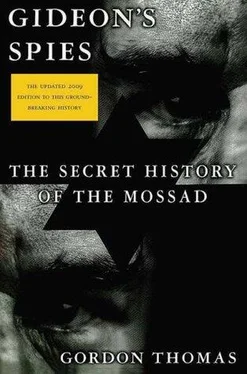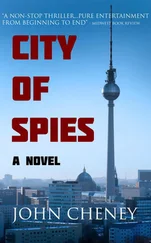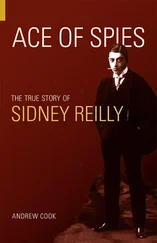Gordon Thomas - Gideon's Spies
Здесь есть возможность читать онлайн «Gordon Thomas - Gideon's Spies» весь текст электронной книги совершенно бесплатно (целиком полную версию без сокращений). В некоторых случаях можно слушать аудио, скачать через торрент в формате fb2 и присутствует краткое содержание. Город: New York, Год выпуска: 2009, ISBN: 2009, Издательство: Thomas Dunne Books, Жанр: История, на английском языке. Описание произведения, (предисловие) а так же отзывы посетителей доступны на портале библиотеки ЛибКат.
- Название:Gideon's Spies
- Автор:
- Издательство:Thomas Dunne Books
- Жанр:
- Год:2009
- Город:New York
- ISBN:978-0-312-53901-6
- Рейтинг книги:4 / 5. Голосов: 1
-
Избранное:Добавить в избранное
- Отзывы:
-
Ваша оценка:
- 80
- 1
- 2
- 3
- 4
- 5
Gideon's Spies: краткое содержание, описание и аннотация
Предлагаем к чтению аннотацию, описание, краткое содержание или предисловие (зависит от того, что написал сам автор книги «Gideon's Spies»). Если вы не нашли необходимую информацию о книге — напишите в комментариях, мы постараемся отыскать её.
Gideon’s Spies
Gideon's Spies — читать онлайн бесплатно полную книгу (весь текст) целиком
Ниже представлен текст книги, разбитый по страницам. Система сохранения места последней прочитанной страницы, позволяет с удобством читать онлайн бесплатно книгу «Gideon's Spies», без необходимости каждый раз заново искать на чём Вы остановились. Поставьте закладку, и сможете в любой момент перейти на страницу, на которой закончили чтение.
Интервал:
Закладка:
In his next meeting with Eli, Poggi had spoken in the soft voice that was long his trademark, his brown eyes watchful, lips pursed before putting a new question, his composed appearance never changing.
But on that cold winter’s night, no doubt physically tired from his travels, he could be forgiven a bounce in his step. Walking into the Apostolic Palace, past the duty Vigili and the Swiss Guards who sprang to attention as he passed, Poggi took the elevator to the Papal Apartments.
The pope’s butler showed Poggi into John Paul’s study. The room’s bookshelves offered clues to the pope’s expanding interests. Along with leather-bound Polish editions of the classics and the works of theologians and philosophers were copies of the International Defence Review and books with such arresting titles as The Problems of Military Readiness and Military Balance and Surprise Attack. They reflected the pontiff’s unswerving conviction that the main enemy the world still faced in 1983 was Soviet Communism.
John Paul had never lost an opportunity to tell his personal staff that before the new millennium dawned, something “decisive” would sweep the world. To all their questions as to what the event would be, he had refused to amplify, shaking his massive head and saying they must all pray that the Church would not lose more ground to Communism or the secularism sweeping countries like the United States, Germany, and Holland. He insisted his life had been spared in St. Peter’s Square to lead the fight back.
Poggi knew that it was this concern, more than any other, which had affected John Paul both mentally and physically. Greetings over, Poggi could not have failed to notice that away from public gaze, John Paul had become more withdrawn. Agca’s bullets had not only shattered bone and tissue, but had created emotional scars that had left the pope introspective and at times remote.
Seated with both hands on his knees, the position Poggi always assumed when there was grave news to impart, the archbishop began to unfold a story that had begun in those first weeks after Agca had shot John Paul.
When news of what had happened in St. Peter’s Square on the afternoon of May 13, 1981, reached Tel Aviv, the immediate reaction of Mossad’s director general, Yitzhak Hofi, was that the shooting had been the work of a crank. Shocking though the incident in Rome had been, it had no direct bearing on Mossad’s current concerns.
Israeli Arabs were becoming ever more radical while, at the same time, Jewish extremists—led by members of the Kahane Kach Party—were becoming more violent. A plot had been discovered just in time to stop them blowing up the most holy Muslim shrine in Jerusalem, the Dome of the Rock. The consequences if they had succeeded were too nightmarish to contemplate. The Lebanon war dragged on despite endless U.S. shuttle diplomacy between Damascus, Beirut, and Jerusalem. In the cabinet, Prime Minister Begin led a party eager for a full-scale “final” showdown with the PLO. Killing Yasser Arafat was still a standing order for Mossad; during the very month the pope was shot there were two unsuccessful attempts to assassinate the PLO chairman.
The fact that seemingly every Western intelligence service was investigating the papal shooting also influenced Hofi’s decision to keep Mossad from becoming involved. In any event, he eventually expected to learn from one of them the background to the incident.
He was still waiting to be told when he was replaced by Nahum Admoni in September 1982. With his Polish background—his parents had been middle-class immigrants from near Gdansk—Admoni had more than a passing curiosity about the Catholic church. In his time abroad working under cover in the United States and France, he had seen how powerful the Church’s influence could be. Rome had helped elect John F. Kennedy, a Catholic, to the White House and, in France, the Church continued to perform an important role in politics.
Once he had settled into office, Admoni sent for Mossad’s file on the attempted papal assassination. It contained mostly news clips and a report from a katsa stationed in Rome that did not go much farther. Unusually, the six security services who had conducted their own inquiries—including interviewing Agca in his high-security cellblock of Rome’s Rebibbia Prison—had failed to pool their knowledge. Admoni decided to conduct his own investigation.
William Casey, then director of Central Intelligence, would later say the likeliest reason appeared to be “Mossad sniffing that maybe here was a way into the Vatican. Admoni had to be thinking he could come up with something to trade off with the Holy See.”
In the wake of Golda Meir’s unsuccessful attempt to establish diplomatic ties with the Vatican, Zvi Zamir had established a permanent Mossad presence in Rome to try to penetrate the Vatican. Working out of a building close to the Israeli embassy, the katsa had tried and failed to recruit priest informers. Most of what he learned was gossip overheard in the bars and restaurants frequented by Vatican staff. He achieved little more than enviously watching the CIA’s head of Rome station drive into the Vatican for his Friday-night briefings to the pope; these had resumed as soon as John Paul had recuperated from his surgery.
During that convalescence, Agostino Casaroli, cardinal secretary of state, had run the Vatican. The katsa had heard that Casaroli had expressed some very blunt sentiments about the shooting: the CIA should have known about Agca and the entire plot. He had sent on the secretary’s views to Tel Aviv.
Within the U.S. intelligence community was a prevailing view that Agca had been a trigger for a KGB-inspired plot to kill the pontiff. In a paper stamped “Top Secret” and titled “Agca’s Attempt to Kill the Pope: The Case for Soviet Involvement,” the argument was made that Moscow had come to fear how the pontiff could ignite the flames of Polish nationalism.
Already by 1981, Solidarity, the country’s workers’ movement under the leadership of Lech Walesa, was increasingly flexing its industrial muscles, and the authorities were under mounting pressure from Moscow to curb the union’s activities.
The pope had urged Walesa to do nothing that would precipitate direct Soviet military intervention. John Paul had urged Poland’s dying cardinal, Stefan Wyszinski, to also reassure the country’s Communist leaders that the pontiff would not allow Solidarity to overstep the mark. When the union scheduled a general strike, Cardinal Wyszinski prostrated himself before Walesa in his office, grabbed the bemused shipyard worker’s trouser leg, and said he would cling on until he died. Walesa called off the strike.
In Tel Aviv, Mossad analysts concluded that the pontiff fully understood the importance of appeasing the Soviets over Poland so as to avoid losing the considerable ground Solidarity had achieved. It seemed increasingly unlikely Moscow would have wanted the pope killed. There was still the possibility that the Soviets had subcontracted the assassination to one of its surrogates. In the past, the Bulgarian secret service had carried out similar missions for the KGB when it was necessary to keep its own involvement hidden. But the analysts thought this time it would be unlikely the KGB would have delegated such an important mission. The Bulgarians would never have conducted the assassination of their own volition.
Nahum Admoni began to explore the CIA’s current involvement with the papacy. In between Casey’s regular visits to the pope, an important player in the relationship between the Vatican and the CIA was Cardinal John Krol of Philadelphia, who shuttled between the White House and the Apostolic Palace. To Monsignor John Magee, the pope’s English-language secretary, Krol was “the Holy Father’s extra-special pal. Both came from a similar background, knew the same Polish songs and stories and could joke across the Pope’s dining table in a local Polish dialect. The rest of us just sat there and smiled, not understanding a word.”
Читать дальшеИнтервал:
Закладка:
Похожие книги на «Gideon's Spies»
Представляем Вашему вниманию похожие книги на «Gideon's Spies» списком для выбора. Мы отобрали схожую по названию и смыслу литературу в надежде предоставить читателям больше вариантов отыскать новые, интересные, ещё непрочитанные произведения.
Обсуждение, отзывы о книге «Gideon's Spies» и просто собственные мнения читателей. Оставьте ваши комментарии, напишите, что Вы думаете о произведении, его смысле или главных героях. Укажите что конкретно понравилось, а что нет, и почему Вы так считаете.












